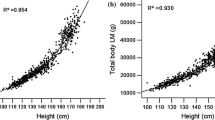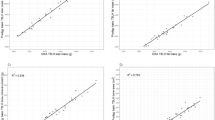Abstract
Background/Objectives:
Dual-energy X-ray absorptiometry (DXA) is considered a specific method for measuring body composition to assess obesity and osteoporosis, although few studies have been conducted in preschool children. The aim of this study was to provide sex - and age-specific references for bone mineral density (BMD), bone mineral content (BMC), fat mass (FM) and fat-free mass (FFM) normative data for children aged 2 to <6 years.
Subjects/Methods:
One hundred and eighty seven healthy white children from Buenos Aires City suburbs, Argentina, were studied by the Lunar DPX-L DXA, pediatric software: BMC less head (g), BMD (g/cm2), FM (%) and FFM (g).
Results:
BMD and BMC increased significantly with age (P<0.0001), but only BMD was significantly different between boys and girls of similar age, being greater for boys (P=0.013). FM was not significantly different among the various age groups of boys and girls. However, the FFM/height was higher in boys and the BMC/FFM was higher in girls. The Z-scores and centile curves were derived separately for each sex and age. Q–Q detrended plots and LMS curves produced robust, unbiased fits that generated references for the 3rd, 50th and 97th percentiles for BMD, BMC, FM and FFM data, respectively.
Conclusions:
These DXA scans add to the scarcity of accurate measurements of body composition of white young children. The data analyses provided greater accuracy, particularly at the upper and lower ends of the distribution, which is important in clinical settings for identification of children with impaired body composition.



Similar content being viewed by others
References
Lifshitz F, Lifshitz JZ . Globesity: the root cause of the obesity epidemic in the USA and now worldwide. Ped Endocrinol Rev 2014; 12: 17–34.
Ogden CL, Carroll MD, Kit BK, Flegal KM . Prevalence of childhood obesity and adult obesity in the United States, 2011-2012. JAMA 2014; 311: 806–814.
de Onis M, Blössner M, Borghi E . Global prevalence and trends of overweight and obesity among preschool children. Am J Clin Nutr 2010; 92: 1257–1264.
Encuesta Nacional de Nutrición y Salud. Dirección Nacional de Salud Materno Infantil. Ministerio de Salud de la Nación, Argentina, 2007. Available at http://www.msal.gov.ar/htm/Site/ennys/site/documento-de-presentacion.asp.
Gaziano JM . Fifth phase of the epidemiologic transition: the age of obesity and inactivity. JAMA 2010; 303: 275–276.
World Health Organization World Health Organization Scientific Group Technical Report. Geneva, Switzerland, 2007..
Chevalley T, Bonjour JP, van Rietbergen B, Ferrari S, Rizzoli R . Fractures during childhood and adolescence in healthy boys: relation with bone mass, microstructure, and strength. J Clin Endocrinol Metab 2011; 96: 3134–3142.
Fors H, Gelander L, Bjarnason R, Albertsson-Wikland K, Bosaeus I . Body composition, as assessed by bioelectrical impedance spectroscopy and dual-energy X-ray absorptiometry, in a healthy paediatric population. Acta Paediatr 2002; 91: 755–760.
Leonard CM, Roza MA, Barr RD, Webber CE . Reproducibility of DXA measurements of bone mineral density and body composition in children. Pediatr Radiol 2009; 39: 148–154.
Binkovitz LA, Henwood MJ, Sparke P . Pediatric DXA: technique, interpretation and clinical applications. Pediatr Radiol 2008; 38: S227–S239.
Helba M, Binkovitz LA . Pediatric body composition analysis with dual-energy X-ray absorptiometry. Pediatr Radiol 2009; 39: 647–656.
Boot AM, Bouquet J, de Ridder MAJ, Krenning EP, de Muinck Keizer-Schrama SM . Determinants of body composition measured by dual energy X-ray absorptiometry in Dutch children and adolescents. Am J Clin Nutr 1997; 66: 232–238.
Kelly TL, Wilson KE, Heymsfield SB . Dual energy X-Ray absorptiometry body composition reference values from NHANES. PLoS One 2009; 4: e7038.
Ward KA, Ashby RL, Roberts SA, Adams JE, Zulf Mughal M . UK reference data for the Hologic QDR Discovery dual-energy X ray absorptiometry scanner in healthy children and young adults aged 6-17 years. Arch Dis Child 2007; 92: 53–59.
van der Sluis IM, de Ridder MA, Boot AM, Krenning EP, de Muinck Keizer-Schrama SM . Reference data for bone density and body composition measured with dual energy X ray absorptiometry in white children and young adults. Arch Dis Child 2002; 87: 341–347.
Kalkwarf HJ, Zemel BS, Gilsanz V, Lappe JM, Horlick M, Oberfield S et al. The bone mineral density in childhood study: bone mineral content and density according to age, sex, and race. J Clin Endocrinol Metab 2007; 92: 2087–2099.
Kocks J, Ward K, Mughal Z, Moncayo R, Adams J, Högler W . Z-score comparability of bone mineral density reference databases for children. J Clin Endocrinol Metab 2010; 95: 4652–4659.
Leonard MB, Propert KJ, Zemel BS, Stallings VA, Feldman HI . Discrepancies in pediatric bone mineral density reference data: potential for misdiagnosis of osteopenia. J Pediatr 1999; 135: 182–188.
Zanchetta JR, Plotkin H, Alvarez Filgueira ML . Bone mass in children: Normative values for the 2-20-year-old population. Bone 1995; 16: S393–S399.
Eisenmann JC, Heelan KA, Welk GJ . Assessing body composition among 3- to 8-year-old children: anthropometry, BIA, and DXA. Obes Res 2004; 12: 1633–1640.
Shypailo RJ, Butte NF, Ellis KJ . DXA: can it be used as a criterion reference for body fat measurements in children? Obesity 2008; 16: 457–462.
Braillon PM, Serban A . Bone mineral content and body composition in overweight children and adolescents. Pediatr Res 2007; 62: 462–467.
Wosje KS, Knipstein BL, Kalkwarf HJ . Measurement error of DXA: interpretation of fat and lean mass changes in obese and non-obese children. J Clin Densitom 2006; 9: 335–340.
Wells JCK, Haron D, Williams JE, Wilson C, Darch T, Viner RM et al. Evaluation of DXA against four-components of body composition in obese children and adolescents aged 5-21 years. Int J Obes 2010; 34: 649–655.
Fields DA, Teague AM, Short KR, Chernausek SD . Evaluation of DXA vs. MRI for body composition measures in 1-month olds. Pediatr Obes 2015; 10: e8–e10.
Fields DA, Demerath EW, Pietrobelli A, Chandler-Laney PC . Body composition at 6 months of life: comparison of air displacement plethysmography and dual-energy X-ray absorptiometry. Obesity 2012; 20: 2302–2306.
de Onis M . Update on the implementation of the WHO child growth standards. World Rev Nutr Diet 2013; 106: 75–82.
International Commission on Radiological Protection (ICRP). The 2007 Recommendations of the International Commission on Radiological Protection. Publication 103. Ann. ICRP 37(2–4).
Pan H, Cole TJ LMS chartmaker, a program to construct growth references using the LMS method. Version 2.43. Available online at http://www.healthforallchildren.co.uk, 2011.
Humphries IR, Hua V, Ban L, Gaskin KJ, Howman-Giles R . Validation of estimates of lean tissue mass made by dual-energy X-ray absorptiometry. Ann NY Acad Sci 2000; 904: 104–106.
Bianchi ML, Baim S, Bishop NJ, Gordon CM, Hans DB, Langman CB et al. Official positions of the International Society for Clinical Densitometry (ISCD) on DXA evaluation in children and adolescents. Pediatr Nephrol 2010; 25: 37–47.
Mattsson S, Thomas BJ . Development of methods for body composition studies. Phys Med Biol 2006; 51: R203–R228.
Sopher AB, Thornton JC, Wang J, Pierson RN Jr, Heymsfield SB, Horlick M . Measurement of percentage of body fat in 411 children and adolescents: a comparison of dual-energy X-ray absorptiometry with a four-compartment model. Pediatrics 2004; 113: 1285–1290.
Binkovitz LA, Henwood MJ . Pediatric DXA: technique and interpretation. Pediatr Radiol 2007; 37: 21–31.
Rodríguez PN, Bermúdez EF, Rodríguez GS, Spina MA, Zeni SN, Friedman SM et al. Body composition by simple anthropometry, bioimpedance and DXA in preschool children: interrelationships among methods. Arch Argent Pediatr 2008; 106: 102–109.
Atherton RR, Williams JE, Wells JC, Fewtrell MS . Use of fat mass and fat free mass standard deviation scores obtained using simple measurement methods in healthy children and patients: comparison with the reference 4-component model. PLoS One 2013; 8: e62139.
Taylor A, Konrad PT, Norman ME, Harcke HT . Total body bone mineral density in young children: influence of head bone mineral density. J Bone Miner Res 1997; 12: 652–655.
Wosie KS, Khoury PR, Clavtor RP, Copeland KA, Hornung RW, Daniels SR et al. Dietary patterns associated with fat and bone mass in young children. Am J Clin Nutr 2010; 92: 294–303.
He Q, Horlick M, Thornton J, Wang J, Pierson RN Jr, Heshka S et al. Sex and race differences in fat distribution among Asian, African-American, and Caucasian prepubertal children. J Clin Endocrinol Metab 2002; 87: 2164–2170.
Cromer BA, Binkovitz L, Ziegler J, Harvey R, Debanne SM . Reference values for bone mineral density in 12- to 18-year-old girls categorized by weight, race, and age. Pediatr Radiol 2004; 34: 787–792.
Looker AC, Melton LJ, Harris T, Borrud L, Shepherd J, McGowan J . Age, gender, and race/ethnic differences in total body and subregional bone density. Osteoporos Int 2009; 20: 1141–1149.
Ellis KJ, Abrams SA, Wong WW . Body composition of a young, multiethnic female population. Am J Clin Nutr 1997; 65: 724–731.
Bacharach LK, Hastie T, Wang MC, Narasimhan B, Marcus R . Bone mineral acquisition in healthy Asian, Hispanic, black, and Caucasian youth: a longitudinal study. J Clin Endocrinol Metab 1999; 84: 4702–4712.
Cure-Cure C, Capozza RF, Cointry GR, Meta M, Cure-Ramírez P, Ferretti JL . Reference charts for the relationships between dual-energy X-ray absorptiometry-assessed bone mineral content and lean mass in 3,063 healthy men and premenopausal and postmenopausal women. Osteoporos Int 2005; 16: 2095–2106.
Fewtrell MS, . British Paediatric & Adolescent Bone Group. Bone densitometry in children assessed by dual x ray absorptiometry: uses and pitfalls. Arch Dis Child 2003; 88: 795–798.
Lewiecki EM, Gordon CM, Baim S, Leonard MB, Bishop NJ, Bianchi ML et al. International Society for Clinical Densitometry 2007 adult and pediatric official positions. Bone 2008; 43: 1115–1121.
Janz KF, Burns TL, Torner JC, Levy SM, Paulos R, Willing MC et al. Physical activity and bone measures in young children: the Iowa bone development study. Pediatrics 2001; 107: 1387–1393.
Tobias JH, Steer CD, Mattocks CG, Riddoch C, Ness AR . Habitual levels of physical activity influence bone mass in 11-year-old children from the United Kingdom: findings from a large population-based cohort. J Bone Miner Res 2007; 22: 101–109.
Högler W, Briody J, Woodhead HJ, Chan A, Cowell CT . Importance of lean mass in the interpretation of total body densitometry in children and adolescents. J Pediatr 2003; 143: 81–88.
Ejlerskov KT, Jensen SM, Christensen LB, Ritz C, Michaelsen KF, Mølgaard C . Prediction of fat-free body mass from bioelectrical impedance and anthropometry among 3-year-old children using DXA. Sci Rep 2014; 4: 3889–3899.
Acknowledgements
We thank Ana María Cora for her technical assistance in DXA measurements. This study was supported by grant UBACyT 20720130100017BA. FL was supported by Pediatric Sunshine Academics, Inc.
Author contributions
PNR and SMF designed the research; PNR, EFB, CAG and JM-R conducted the research; JPH, PNR and PLC analyzed the data; PNR, FL and SMF wrote the paper; and PNR and FL had primary responsibility for the final content. All authors read and approved the final manuscript.
Author information
Authors and Affiliations
Corresponding author
Ethics declarations
Competing interests
The authors declare no conflict of interest.
Rights and permissions
About this article
Cite this article
Lifshitz, F., Hecht, J., Bermúdez, E. et al. Body composition analysis by dual-energy X-ray absorptiometry in young preschool children. Eur J Clin Nutr 70, 1203–1209 (2016). https://doi.org/10.1038/ejcn.2016.38
Received:
Revised:
Accepted:
Published:
Issue Date:
DOI: https://doi.org/10.1038/ejcn.2016.38
- Springer Nature Limited
This article is cited by
-
Effective dose of propofol combined with intravenous esketamine for smooth flexible laryngeal mask airway insertion in two distinct age groups of preschool children
BMC Anesthesiology (2024)
-
Assessment of Bone Health Using Dual-Energy X-Ray Absorptiometry (DEXA) And Its Association with Dietary Intakes, Serum Vitamin D Levels, and Anthropometric Measures in Healthy Urban Preschool Children
Indian Journal of Pediatrics (2023)
-
Official Position of the Brazilian Association of Bone Assessment and Metabolism (ABRASSO) on the evaluation of body composition by densitometry—part II (clinical aspects): interpretation, reporting, and special situations
Advances in Rheumatology (2022)




